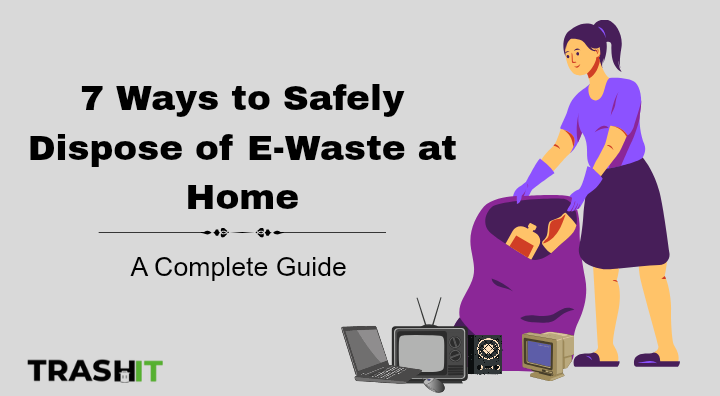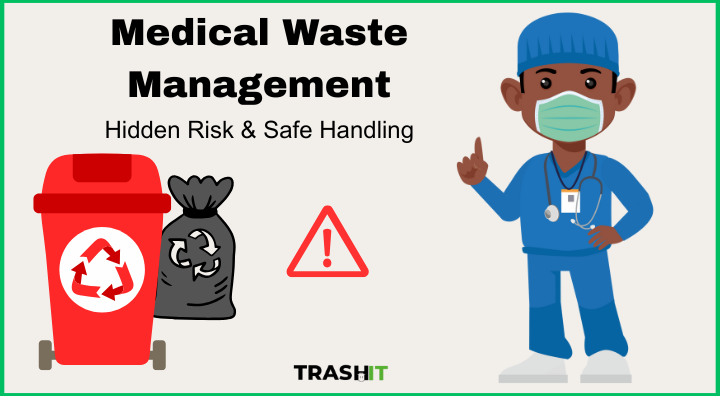
Have you thought about ways to dispose of e-waste at home safely? That’s what we are going to discuss from today.
Keep reading…
Electronic waste, or e-waste, represents one of the fastest-growing environmental challenges globally.
With 62 million tons of e-waste generated globally in 2022, and only 22.3% properly collected and recycled, we need urgent action at the household level..
Want the fastest way to dispose of your old gadgets responsibly in Nigeria? Book a free pickup with TrashIt today
As this device ages, breaks, or gets replaced, you often toss it aside or into the garbage bin.
This discarded gadget is known as electronic waste, or e-waste, which represents one of the fastest-growing environmental challenges globally.
Apart from that, this has caused more serious health and environmental hazards.
For example, lead, mercury, and cadmium from old devices can pour into the soil and water, and lithium batteries can also spark fires in landfills or on dry grass.
Sometimes, e-waste materials such as copper, silver, and gold can be recovered and reused if handled correctly.
So, the need to know how to properly or safely dispose of electronics at your home has become a challenge to you so other not to harm the planet or compromise your personal data.
This comprehensive guide outlines seven safe and effective ways to dispose of electronic devices from your home while protecting both your personal data and the environment.
Understanding E-Waste and Its Impact
E-waste covers any discarded product with a plug or battery, including smartphones, computers, televisions, printers, and household appliances.
As this device ages, breaks, or gets replaced, you often toss it aside or into the garbage bin.
If you dispose of it improperly, the toxic materials can leach into soil and groundwater, causing serious health risks and environmental hazards.
These devices contain both valuable materials like gold, silver, and copper, as well as hazardous substances such as lead, mercury, cadmium, and brominated flame retardants.
When improperly disposed of, these toxic materials can leach into soil and groundwater, causing significant environmental and health risks.
The scale of the problem is staggering. Researchers project that it will reach 82 million tons by 2030.
Currently, an estimated 347 million tons of unrecycled e-waste remain globally, representing a massive loss of recoverable resources worth approximately $62 billion annually.
Method 1: Certified E-Waste Recycling Centers
One of the most reliable ways to handle old electronics is by taking them to a certified e-waste recycling facility.
What Is Involved: Take your electronic to specialized facilities equipped to handle hazardous materials safely.
One of the most reliable ways to handle old electronics is by taking them to a certified e-waste recycling facility.
Skip the stress — TrashIt picks up your devices directly from your home. Our team dismantles, sorts, and processes e-waste safely, recovering valuable materials and keeping toxins out of the environment.
Schedule a pickup now and let TrashIt handle the rest.
Best For: many electronics, especially items containing dangerous substances like CRT monitors, batteries, and devices with mercury components.
The Process:
Certified recycling centers follow strict protocols to ensure environmentally sound processing.
What to do is begin by locating facilities using online directories such as the EPA’s electronics recycling locator or Earth911.com.
Before transport, remove all batteries and accessories, as many facilities require separate handling for different components.
Contact the facility to confirm operating hours, accepted items, and any specific preparation requirements.
Benefits And Considerations:
These facilities, like TrashIt Recycling Company, employ trained professionals who can safely extract valuable materials while properly containing hazardous substances.
The recycling process involves manual sorting, examination for functional parts, de-manufacturing to remove dangerous materials, and separation of metals and non-magnetic materials using specialized equipment.
However, some facilities may charge fees, particularly for items like CRT monitors, which can contain 2-5 pounds of lead per unit and require special handling.
Method 2: Manufacturer Take-Back Programs
Many electronics manufacturers now offer take-back or recycling programs, where you can return old devices directly to the brand for responsible disposal—or even trade-in credits.
For example, TrashIt Recycling Company empowers green and ecologically friendly communities through recycling.
What it involves: Returning devices to their original manufacturers through official recycling programs.
Best For: Newer electronics with active manufacturer support, particularly Apple, HP, Dell, and other major brands that offer comprehensive take-back services.
The Process:
Major manufacturers have established robust recycling programs. **Apple’s Trade-In and Recycling Program** accepts all Apple devices, offering trade-in credit for functional items or free recycling for non-functional ones.
The company uses advanced robots like Daisy and Dave to disassemble devices and recover valuable materials, including aluminum, cobalt, and rare earth elements.
Similarly, HP’s Planet Partners program provides free return shipping for HP products, while other manufacturers offer similar services through their official websites.
Benefits:
Manufacturer programs ensure devices are processed by experts familiar with specific product designs.
Many offers trade-in values or discounts on new purchases, and companies like Apple guarantee secure data erasure before processing.
These programs also support manufacturers’ sustainability goals, with Apple aiming to produce all devices from 100% recycled or renewable materials.
Method 3: Retailer Collection Programs
Major retailers often serve as convenient collection points for e-waste.
What It Involves: Go to electronics stores or major retailers that accept old devices for recycling
Best For: small electronics, accessories, and situations where convenience is a priority.
The Process:
TrashIt Integrated Service leads the retail recycling space in Port Harcourt, having collected millions of pounds of electronics since 2023, making them one of Nigeria’s largest retail e-waste collectors.
TrashIt Integrated Service accepts up to three items per household per day at various locations.
We’re taking TVs (up to 50 inches), computers, tablets, smartphones, audio devices, and other appliances.
TrashIt Integrated Services also offers a Saturday Standalone Pickup Service for only ₦7,000 — perfect for large items.
Find your nearest drop-off or book a pickup here
Other major retailers like Staples and Office Depot provide Standalone Hair hair-away services, often with collection bins for smaller items like batteries and accessories.
Limitations And Benefits:
Retail programs like (TrashIt Integrated Service) typically have quantity restrictions and may charge fees for certain items.
However, they offer the advantage of immediate processing and often provide trade-in options for functional devices.
Method 4: Community Collection Events
What It Involves: Participating in organized municipal or community-sponsored e-waste collection drives.
Best For: Large quantities of e-waste, bulky items, or households in areas with limited permanent collection options.
The Process:
Community events are typically organized by local governments, environmental groups, or waste management companies.
These events are often announced through municipal websites, community bulletins, and local news outlets.
Participants bring their e-waste to designated collection sites during specified hours, where trained personnel sort and prepare items for proper recycling.
Stay informed: Subscribe to TrashIt updates and never miss an event near you.
Preparation And Benefits:
Events usually provide guidelines for item preparation, which include requirements for removing batteries and personal data.
Some of these events are free of charge and accept items that might incur fees at commercial facilities.
These events also build community engagement and environmental awareness, and at the same time provide convenient disposal options for residents.
Method 5: Mail-In Recycling Programs
What It Involves: Shipping electronics to certified recyclers requires the use of specialized packaging and shipping procedures.
Best For: Small devices, households in remote areas, or situations where local options are limited.
The Process:
Several certified recyclers offer mail-in services that come with prepaid shipping labels.
Companies provide specific packaging instructions in order to make sure of safe transport, especially for items containing batteries or other hazardous materials.
On the other hand, some programs require customers to request mail-in kits, while others allow direct shipping to designated facilities.
Safety And Compliance:
Mail-in programs must comply with hazardous material shipping regulations, particularly for lithium batteries, which are classified to be dangerous goods.
When there is proper packaging, it will prevent short circuits and reduce fire risk during transit.
As for remote locations, shipping costs and packaging requirements may make this option less economical for larger items.
Method 6: Battery-Specific Disposal Methods
What It Involves: This has to do with separating collection and disposal procedures for different battery types.
Critical Safety Considerations:
Battery disposal often requires special attention because of fire and chemical hazards.
For example, Lithium-ion batteries are among the e-waste items that pose significant risk…, it should never be placed in regular trash because of potential thermal runaway and fire hazards.
The EPA specifically warns against household disposal of these batteries because of their reactive nature.
Disposal Procedures by Battery Type:
- Lithium-ion batteries: Remove the batteries from devices, cover the battery terminals with tape to prevent short circuits, then take them to certified collection points
- Household Alkaline Batteries: Many supermarkets and electronics stores provide collection bins
- Rechargeable Batteries: Specialized programs through retailers like Best Buy or manufacturer take-back services.
For more details on TrashIt Take Back Service, contact TrashIt Integrated Service Contact Page.
Storage And Transport Safety:
You should always store damaged or swollen batteries in fireproof containers away from heat sources.
Don’t try or attempt to disassemble batteries; always transport them in non-metal containers to prevent electrical conductivity issues.
If a lithium battery appears damaged, swollen, or has been exposed to heat, you should treat it as hazardous waste.
Method 7: Donation and Resale for Functional Electronics
What It Involves: Finding new homes for working electronics through donation or resale.
Best For: Functional devices in good condition that can extend their useful life.
The Process:
Before donation or resale, thoroughly test device functionality and cosmetic condition.
Clean devices inside and out, making sure that all ports and connections work properly.
Complete a comprehensive data wipe using factory reset procedures or specialized data erasure software.
Include original accessories, manuals, and packaging when available to maximize value and usability.
Data Security Protocol:
Have it in mind that data protection is crucial before transferring ownership.
Do this by simply deleting or formatting; it’s insufficient.
Use specialized data wiping software that overwrites data multiple times.
For devices with removable storage, you should consider physical destruction of drives containing sensitive information.
The CISA (Cybersecurity and Infrastructure Security Agency) provides specific guidelines for secure data elimination before disposal.
You can check it out in the article entitled “Proper Disposal of Electronic Devices “.
Donation And Resale Channels:
Know that schools, nonprofits, and community centers often accept functional electronics.
Online platforms like eBay, Facebook Marketplace, or specialized electronics resale sites provide options for recovering some value.
Some manufacturers and retailers’ trade-in programs offer credit toward new purchases for functional devices.
Essential Pre-Disposal Preparation Steps
Data Security Measures
Complete Data Backup: Before you decide to try any disposal method, first, back up important files to external storage or cloud services.
This makes sure that you don’t lose valuable data during the disposal process.
Comprehensive Data Erasure: Perform factory resets on all devices, but understand that this method alone may not be sufficient for complete data protection.
Here is what to do: use specialized data wiping software that overwrites data multiple times, making recovery virtually impossible.
As for highly sensitive data, you should consider physical destruction of storage devices.
Account and Service Deactivation: Sign out of all your accounts, de-authorize devices from services like iTunes or Google accounts, and remove devices from find-my-device services.
This method prevents unauthorized access and ensures a smooth transition to new devices.
Physical Preparation
Battery And Accessory Removal: Remove all batteries from devices, as many recycling facilities require separate processing.
Collect all accessories, cables, and removable components for appropriate disposal or reuse.
Device Documentation: Record serial numbers and take photographs of valuable items for insurance or tax deduction purposes.
Keep receipts for any disposal fees paid, as these may be tax-deductible.
Safe Transportation: Package fragile items securely; this can prevent damage during transport.
Heavy items like CRT monitors require careful handling because of their lead content and high-voltage components that can remain dangerous even when unplugged.
Critical Safety Considerations
Hazardous Material Awareness
CRT Monitor Dangers: Older cathode ray tube monitors and televisions contain significant amounts of lead and maintain high voltage even when disconnected.
These items require professional handling, and you should not attempt dismantling at home.
TrashIt professionals are trained to manage hazardous e-waste safely. Book a call today and let us handle it for you. Request a callback here.
Battery Fire Risks: Lithium-ion batteries can cause fires if damaged, overheated, or improperly stored.
Signs of battery failure include…
- Swelling
- Unusual heat
- Visible damage to the casing
Store damaged batteries in fireproof containers and dispose of them immediately at certified facilities.
Personal Protection: When you are handling potentially damaged electronics, always wear protective equipment like gloves and eye protection.
Never attempt to disassemble devices yourself, particularly those containing batteries or high-voltage components.
Transportation Safety
Vehicle Loading: Secure heavy items properly in vehicles to prevent shifting during transport
Know that CRT monitors and old televisions can weigh 50-100 pounds and pose injury risks if not handled correctly.
Hazardous Material Compliance: If shipping electronics, make sure you follow all applicable regulations for hazardous materials, especially regarding battery transport.
Many shipping companies have specific requirements for electronic devices containing lithium batteries.
Environmental And Economic Benefits
Environmental Protection
Proper e-waste disposal prevents approximately 58,000 kilograms of mercury and 45 million kilograms of brominated flame-retardant plastics from entering the environment annually.
When electronics reach landfills, toxic substances leach into soil and groundwater, affecting both wildlife and human populations.
Recycling electronics reduces the need to dig up, drill, or otherwise extract “virgin” (new, raw) materials from the earth, which accounts for 7% of global energy consumption.
Using recycled metals is 2-10 times more energy efficient than smelting from virgin ore, significantly reducing carbon emissions.
For example, mining gold from discarded electronics produces 80% fewer carbon dioxide emissions compared to traditional mining.
Economic Value Recovery
The $62 billion worth of recoverable material in e-waste represents a massive economic opportunity.
Precious metals like gold, silver, and platinum, along with critical materials like cobalt and rare earth elements, can be recovered and reused.
However, currently, less than 1% of rare earth element demand is met through e-waste recycling, representing significant untapped potential.
Achieving a 60% global recycling rate by 2030 would generate economic, health, and environmental benefits exceeding $38 billion more than the associated costs.
Conclusion
Safe e-waste disposal requires understanding both the environmental stakes and available disposal methods.
With e-waste generation rising five times faster than documented recycling rates, individual action becomes increasingly crucial.
The seven methods I discuss in this article provide comprehensive options for every household situation.
Data security preparation and safety awareness are non-negotiable aspects of responsible e-waste disposal.
The combination of proper data erasure, appropriate disposal method selection, and adherence to safety protocols ensures both personal protection and environmental stewardship.
By choosing appropriate disposal methods for your specific electronics and circumstances, you contribute to recovering valuable materials, preventing environmental contamination, and supporting the development of sustainable technology cycles.
The time to act is now; every household that takes part in the disposal program will make a difference in addressing this growing global challenge.
Take the first step today by identifying your local e-waste recycling options and preparing your unused electronics for safe, responsible disposal.
Your actions today help build the circular economy needed for a sustainable technological future.
Join thousands of households already making an impact with TrashIt. Sign up today for your free weekly on waste management and recycling updates and tips


